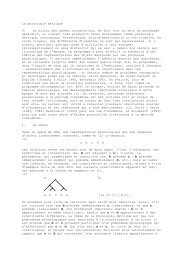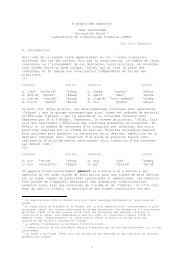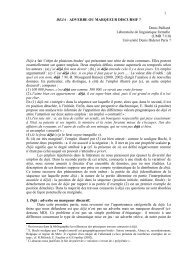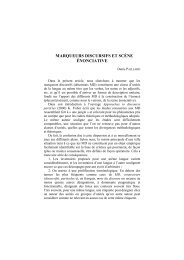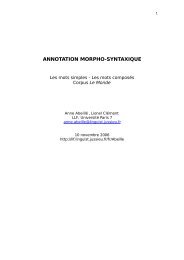CV as the only syllable type Jean Lowenstamm
CV as the only syllable type Jean Lowenstamm
CV as the only syllable type Jean Lowenstamm
You also want an ePaper? Increase the reach of your titles
YUMPU automatically turns print PDFs into web optimized ePapers that Google loves.
h a n a 9 a r ø h a n a 9 a r ø<br />
| |<br />
GEM<br />
| | | | | | | | / \ | | | | |<br />
C V C V<br />
| |<br />
C V C V C V<br />
| | | | | |<br />
---> C V C V C V C V C V<br />
| \ / | | | | | |<br />
CL<br />
h a 9 e r e b h a 9 e r e b ø<br />
All <strong>the</strong> arguments presented in this section have a common feature: in<br />
each c<strong>as</strong>e, once <strong>the</strong> binyan h<strong>as</strong> been identified, we can independantly control <strong>the</strong><br />
distance between both margins of a given entry. This access to <strong>the</strong> topology of a<br />
form makes it possible, in principle, to precisely determine <strong>the</strong> exact portion of<br />
<strong>the</strong> binyan occupied by any given segment, a crucial tool in <strong>the</strong> detection of<br />
empty nuclei or onsets. While such morphological information is not <strong>as</strong> readily<br />
available in non-templatic systems, <strong>the</strong> phonology of languages from <strong>the</strong> latter<br />
group does not appear to abide by radically different principles.<br />
In <strong>the</strong> next section, I examine <strong>the</strong> plausibility of extending a <strong>CV</strong><strong>CV</strong><br />
treatment to non-templatic languages.<br />
3 Beyond templatic languages<br />
3.1 Three sets of facts<br />
I will start by considering three sets of facts suggesting that clusters, long vowels<br />
and geminate consonants are handled in similar f<strong>as</strong>hion by templatic and nontemplatic<br />
languages alike. First, briefly consider CL again. Its operation in Latin<br />
is no different from TH. Indeed, <strong>the</strong> change from reconstructed [k<strong>as</strong>nus] to<br />
attested [ka:nus] can be represented with similar devices, <strong>as</strong> in (27).<br />
(27)<br />
Latin k<strong>as</strong>nus ----> ka:nus<br />
k a s n u s ø<br />
BEFORE | | | | | | |<br />
C V C V C V C V<br />
AFTER | \ / | | | |<br />
k a n u s ø<br />
Second, consider <strong>the</strong> facts of Standard Italian and Cl<strong>as</strong>sical Arabic in (28).<br />
(28)<br />
St. Italian<br />
Cl. Arabic<br />
a.<br />
b.<br />
fatto<br />
fa:to<br />
kattaba<br />
ka:taba<br />
c. *fa:tto *ka:ttaba



